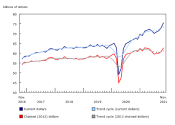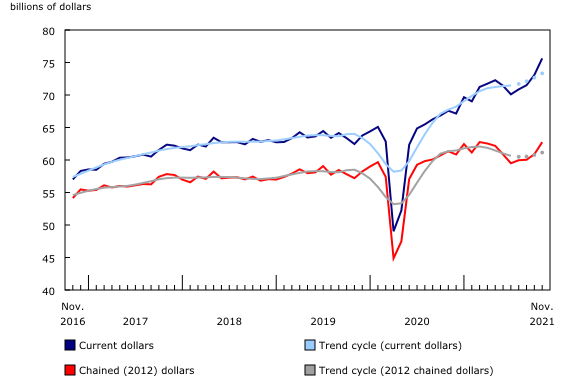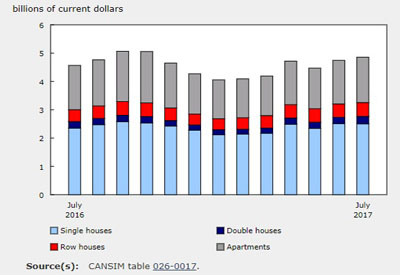Wholesale Trade, November 2021

January 19, 2022
Wholesale sales rise for a fourth consecutive month
Wholesale sales rose 3.5% in November to $75.6 billion, the fourth consecutive monthly increase. Sales increased in six of the seven subsectors, representing nearly 99% of total wholesale sales. The largest increases came in the building materials and supplies, and miscellaneous products subsectors. The growth came despite the impact of severe flooding and transportation disruptions in British Columbia in November.
Constant dollar sales increased 3.1% in November.
Building materials and supplies lead gains
Sales of building materials and supplies rose 7.1% in November to $12.3 billion, reflecting gains in the lumber, millwork, hardware and other building supplies industry, and the metal service centres industry. This was the third increase in the past four months, and sales in November 2021 were 20.7% higher than November 2020. The higher sales throughout 2021 in the building material and supplies subsector were supported by continued strong demand for new home builds and renovations. Cumulative home starts in 2021 from January to November were 28.5% higher than in the same period in 2020. And home renovation spending from January to November 2021 was 29.8% higher than in the same period in 2020.
Miscellaneous wholesaler sales grew 5.0% to $11.3 billion in November, on the strength of increases in the agricultural supplies (e.g., feed and seed), and the chemical and allied product industries. Sales hit an all-time high in November 2021, and were 29.3% higher than in November 2020. The increases partially reflected ongoing demand for Canadian potash abroad, as exports of potash rose 9.7% in November 2021.
Motor vehicle and motor vehicle parts and accessories sales rose 4.5% in November to $11.4 billion. It was the second consecutive monthly increase in the subsector, reaching the highest level since February 2020, which was before the pandemic. Many motor vehicle assembly plants across North America expanded production in November, as some semi-conductor chips were received.
British Columbia flooding
During the collection of data for November 2021, the Monthly Wholesale Trade Survey asked all survey respondents questions regarding the impact of the major storms and flooding that hit British Columbia in November. The data below provide an assessment of the impact of the flooding on Canadian wholesale sales.
Overall, it is estimated that, nationally, the flooding caused approximately $600 million of loss in wholesale sales. The hardest hit industries were the agricultural supplies industry which reported $105 million in lost sales, and the lumber, millwork and other building supplies industry, which reported $85 million in lost sales. However, lost sales were not the largest impact of the flooding. The significant majority of respondents affected by the storms indicated that logistical and shipping issues were the major concern. As such, delayed sales, delayed shipments, reduced access to raw materials and increased costs for shipping via air cargo were the main effects of the inundation.
Higher sales in seven provinces
Sales increased in seven provinces and two territories in November, accounting for 98% of total wholesale sales. Alberta, Ontario and Quebec led the gains.
Alberta recorded its largest monthly increase on record, with a 12.1% jump in sales to $8.3 billion, which was also the highest level ever. The machinery, equipment and supplies subsector led the increase, up 16.2% to $2.5 billion, as wholesalers of construction, forestry, mining and industrial machinery, equipment and supplies reported a 25.2% increase in sales. Together with higher sales in the food, beverage and tobacco (+14.9%), and building material and supplies (+13.3%) subsectors, the three subsectors accounted for 86% of the province’s monthly increase. Farm product wholesalers reported the only decrease, down 4.0% to $138.9 million.
Manitoba and Saskatchewan also saw record sales in November. The growth in the Prairie provinces reflected the strength of the energy product sector and high commodity prices for items such as chemical fertilizer and potash.
Sales in Ontario rose for the fifth consecutive month, up 2.2% to $38.2 billion in November. The increase was led by the building material and supplies subsector, up 7.7% to $5.2 billion, closely followed by the motor vehicle and motor vehicle parts and accessories subsector (+4.8%), and the miscellaneous subsector (+6.3%). The gains in these three subsectors totalled $1.0 billion, which was dampened by a 3.8% fall in sales of food, beverage and tobacco. Notwithstanding decreased sales in three of seven subsectors, sales in Ontario were also the highest on record.
In Quebec, sales rose 4.7% to $14.6 billion in November. The largest gain came from the building material and supplies subsector, up 13.2% to $2.6 billion, which accounted for 46% of Quebec’s increase. All component industries of the subsector had higher sales; however, nearly half was because of a 28.4% increase in metal service centre sales.
Value of inventories continues to climb
The value of wholesale inventories expanded 4.3% to $103.5 billion in November. This was the seventh consecutive month of growth, and a new high for inventories, which crossed the 100-billion mark for the first time on record.
Five of seven subsectors had larger inventories at the end of November; they comprised 89% of the value of inventories in the sector.
Inventories in the personal and household goods subsector grew 11.2% to $17.9 billion. All component inventories were larger in November, but the increase was driven by pharmaceuticals and pharmacy supplies, which accounted for 72% of the change and 45% of inventories in the subsector.
Pharmaceuticals and pharmacy supplies wholesalers carried $1.3 billion more in inventories at the end of November. Canada imported $1.2 billion more pharmaceuticals and medical products in November than October.
Building material and supplies merchant wholesalers reported a 7.7% increase in the value of their inventories, which stood at $19.7 billion at the end of the month. Inventories in all component industries grew, but the inventories of metal service centres grew the most, up 18.8% to $6.1 billion. The contribution of metal service centres accounted for roughly two-thirds of the change in the subsector, despite comprising approximately one-third of the value of its inventories.
Farm product wholesalers’ and food, beverage and tobacco merchant wholesalers’ inventories decreased 0.8% and 0.4%, respectively.
The inventory-to-sales ratio increased from 1.36 to 1.37 in November. This ratio is a measure of the time (in months) required to exhaust inventories if sales were to remain at their levels.
Go HERE for more information











